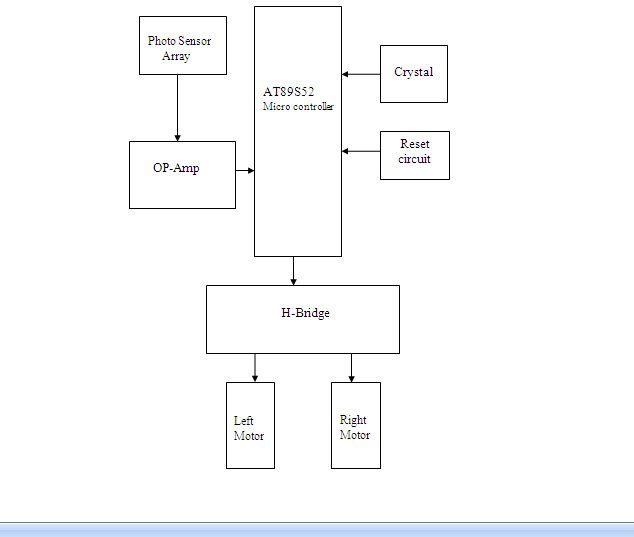IMPLEMENTATION
OF ARTIFICIAL EYE FOR INTELLIGENT LINE FOLLOWING ROBOT APPLICATION
TECHNICAL SPECIFICATIONS:
Title of the project : Implementation of Artificial Eye for Intelligent Line
Following Robot
Domain : Robotics, Wireless Communication
Software : Embedded C, Keil, Proload
Microcontroller : AT89S52
Power Supply
: +9V, 500mA Regulated
Power Supply
ABSTRACT:
For many people robot is a machine that
imitates a human—like the androids in Star Wars, Terminator and Star Trek: The
Next Generation. However much these robots capture our imagination, such robots
still only inhabit Science Fiction. People still haven't been able to give a
robot enough 'common sense' to reliably interact with a dynamic world.
The type of robots that you will encounter
most frequently are robots that do work that is too dangerous, boring, onerous,
or just plain nasty. Most of the robots in the world are of this type. They can
be found in auto, medical, manufacturing and space industries. In fact, there
are over a million of these type of robots working for us today.
Some robots like the Mars Rover Sojourner and the upcoming
Mars Exploration Rover, or the
underwater robot Caribou
help us learn about places that are too dangerous for us to go. While other
types of robots are just plain fun for kids of all ages. Popular toys such as Teckno, Polly or AIBO ERS-220 seem to hit the store shelves
every year around Christmas time.
What exactly is a robot?
As strange as it might seem, there really is
no standard definition for a robot. However, there are some essential
characteristics that a robot must have and this might help you to decide what
is and what not a robot is. It will also help you to decide what features you
will need to build into a machine before it can count as a robot.
A robot has these essential characteristics:
Sensing First of all your
robot would have to be able to sense its surroundings. It would do this in ways
that are not unsimilar to the way that you sense your surroundings. Giving your
robot sensors:
light sensors (eyes), touch and pressure sensors (hands), chemical sensors (nose), hearing and sonar sensors
(ears), and taste sensors
(tongue) will give your robot awareness of its environment.
Movement A robot needs to
be able to move around its environment. Whether rolling on wheels, walking on
legs or propelling by thrusters a robot needs to be able to move. To count as a
robot the whole robot moves, either like the Sojourner or just parts of the
robot moves, like the Canada Arm.
Energy A robot needs to
be able to power itself. A robot might be solar powered, electrically powered,
battery powered. The way your robot gets its energy will depend on what your
robot needs to do.
Intelligence A robot
needs some kind of "smarts." This is where programming enters the
pictures. A programmer is the person who gives the robot its 'smarts.' The
robot will have to have some way to receive the program so that it knows what
it is to do.
So what is a robot?
Well it is a system that contains
sensors, control systems, manipulators, power supplies and software all working
together to perform a task. Designing, building, programming and testing a
robots is a combination of physics, mechanical engineering, electrical
engineering, structural engineering, mathematics and computing. In some cases
biology, medicine, chemistry might also be involved. A study of robotics means
that students are actively engaged with all of these disciplines in a deeply
problem-posing problem-solving environment.
What is a line follower?
Line follower is a machine that
can follow a path. The path can be visible like a black line on a white surface
(or vice-versa) or it can be invisible like a magnetic field.
Why build a line follower?
Sensing a line and maneuvering
the robot to stay on course, while constantly correcting wrong moves using
feedback mechanism forms a simple yet effective closed loop system. As a
programmer you get an opportunity to ‘teach’ the robot how to follow the line
thus giving it a human-like property of responding to stimuli.
Practical applications of a line follower: Automated cars running
on roads with embedded magnets; guidance system for industrial robots moving on
shop floor etc.
EMBEDDED SYSTEMS:
An embedded
system is a combination of software and hardware to perform a dedicated task. Some
of the main devices used in embedded products are Microprocessors and
Microcontrollers. Microprocessors are commonly referred to as general purpose
processors as they simply accept the inputs, process it and give the output. In
contrast, a microcontroller not only accepts the data as inputs but also
manipulates it, interfaces the data with various devices, controls the data and
thus finally gives the result.
All these tasks are possible
with the microcontroller because the microcontroller has a CPU in addition to a
fixed amount of RAM, ROM, I/O ports and timer all on a single chip. This fixed
amount of RAM, ROM and number of I/O ports in microcontroller makes them ideal
for many applications where cost and space are critical.






No comments:
Post a Comment